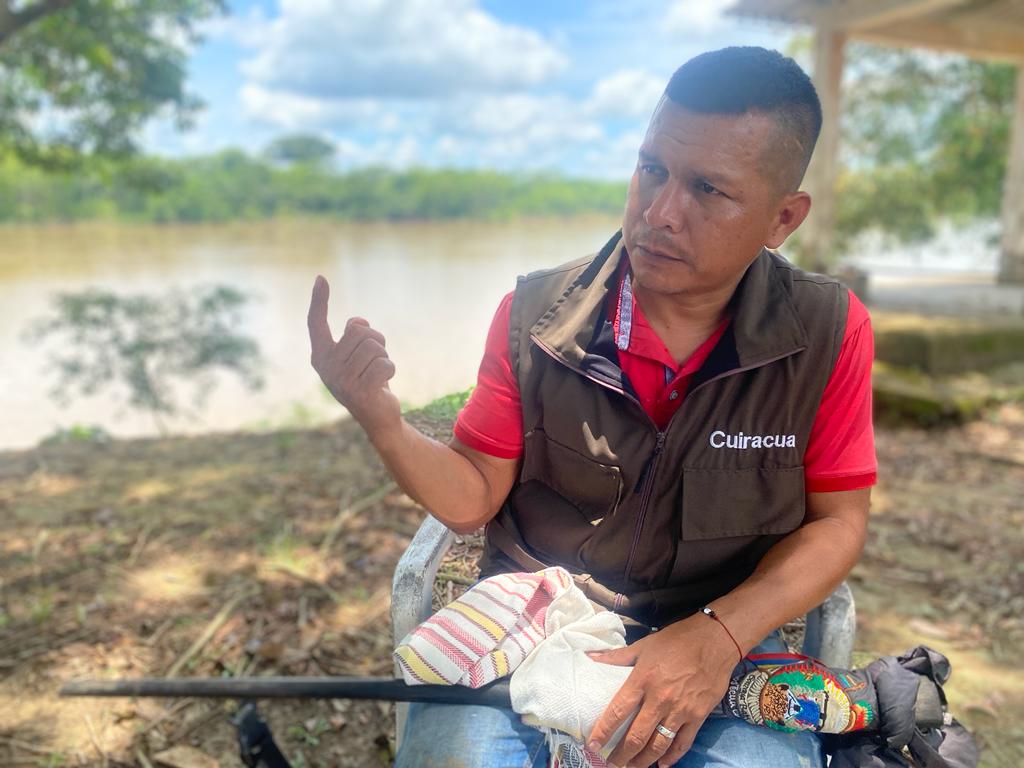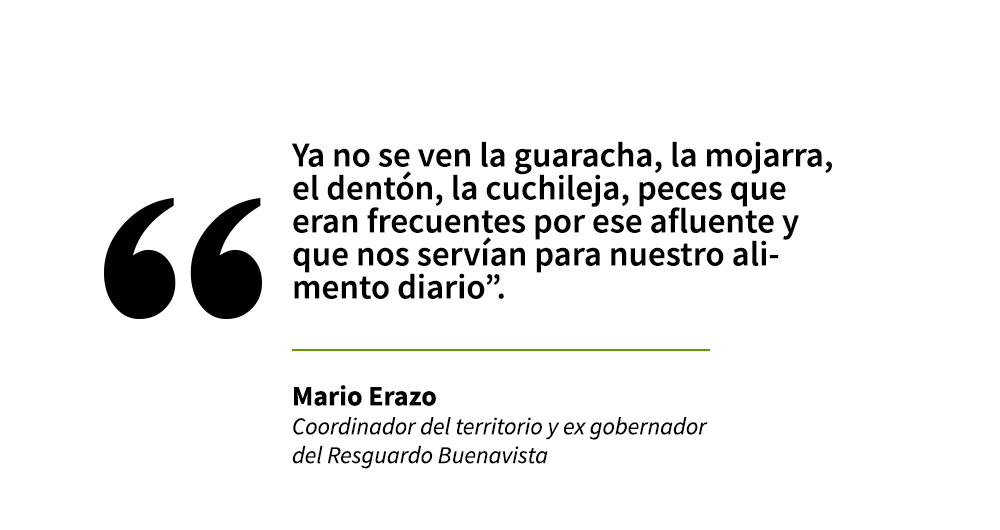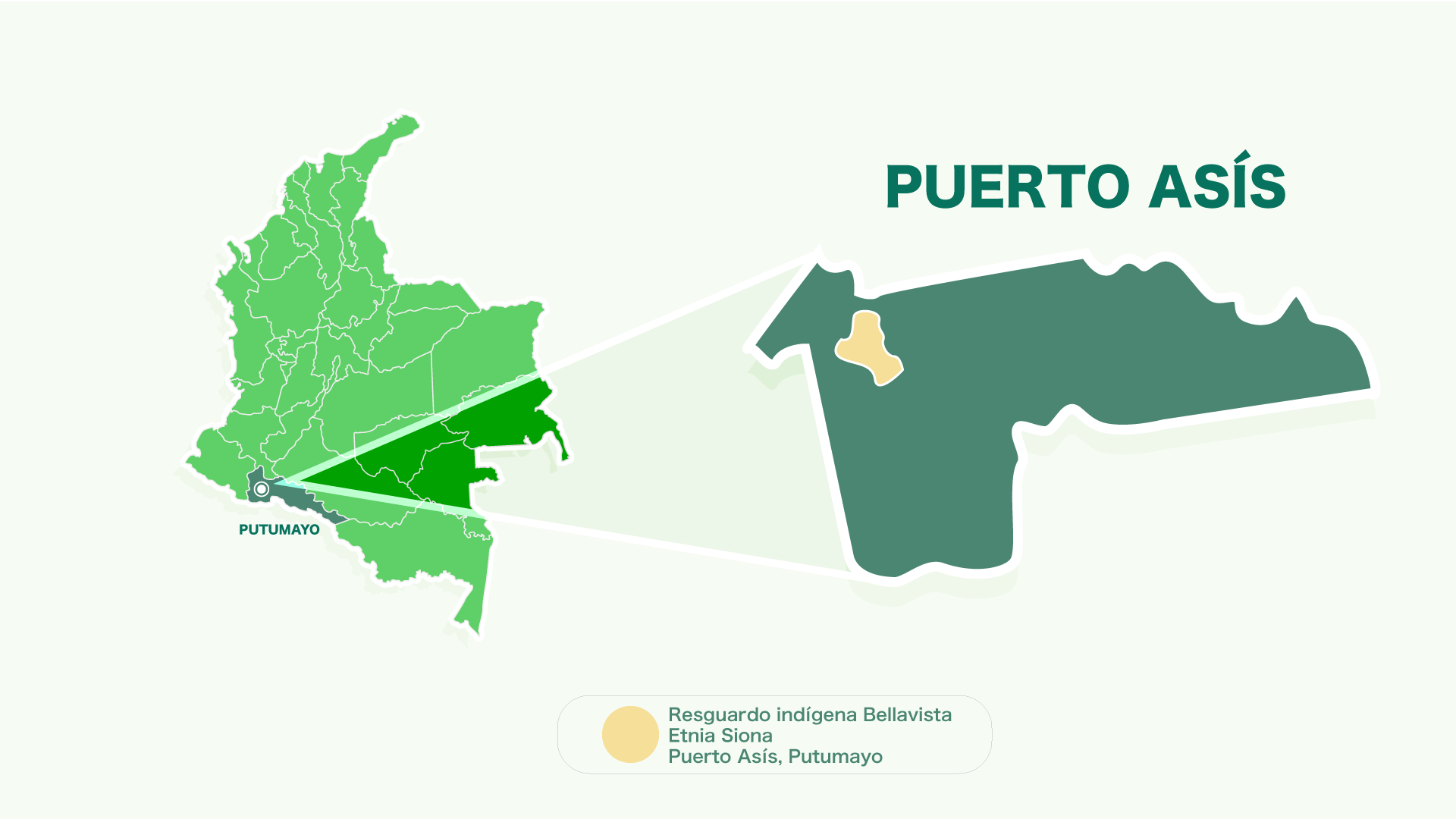- The Constitutional Court declared that the subsistence of the Siona people is seriously threatened and they could disappear. They have been fighting for 13 years against an oil project that they claim affects their territory. In the Buenavista reservation, where the Platanillo block is located, the inhabitants point out that several streams are drying up due to hydrocarbon extraction activities.
- Coca crops, extensive cattle ranching, illegal logging, antipersonnel mines, and dissidents surround the indigenous territory located on the banks of the Putumayo River, on the border shared by Ecuador and Colombia.
* This report is a journalistic collaboration between Mongabay Latam and Free Zone
Some 90 houses separated from each other by a few meters and surrounded by trees of canangucha, arazá, pomoroso, cocona, cupoazu, carambolo and other Amazonian fruits house the inhabitants of the Buenavista reservation of Puerto Asís. It is the largest community of the Siona people of the twelve that survive on the banks of the Putumayo and Piñuña Blanco rivers, on the Colombian side. There are a little more than a hundred families that live between the water, the jungle and the prayers of the taitas or older who try to protect the land in the malocathe house that shelters their traditions and stands on the border with the forest.
In the center of the community there is a dirt soccer field, with the goals raised with a few sticks, next to a communal room that during the day is the place where visitors are received. It is also the meeting and fun place of this town that can be reached by three different routes: from the municipality of Puerto Asís, by boat on the Putumayo River or in sections, first by a battered road and then by water. The third option is from Ecuador, through the province of Sucumbíos, about 15 minutes from the site where Operation Fénix took place, in which Raúl Reyes, one of the top guerrilla commanders of the Revolutionary Armed Forces of Ecuador, was assassinated in 2008. Colombia (FARC), in an illegal incursion of the Colombian Military Forces into the territory of the neighboring country.
The Siona have had to get used to living close to those events of the war, of which they have not been oblivious. They, in no way, think of leaving the place where water is part of their cosmogony and their means of subsistence, since fishing is one of their activities.
Mario Erazo, coordinator of the territory and former governor of the Buenavista reservation, has always lived on this enormity of land of some 4,500 hectares, the most representative leader of the Siona people for almost a decade, when he began his fight against the oil companies; a battle to which conflicts with settlers and peasants are now added due to the effects caused by coca crops, extensive cattle ranching and illegal logging.
Today The Siona have not ceased in their fight against the oil company, but in the past, at the beginning of the 20th century, they dealt with the extractive projects of cinchona and rubber in the Buenavista and San José de Wisuya reservations in Ecuador.
Mario Erazo is used to fighting, as well as responding to journalists or documentary producers. In addition, little by little he is adapting to a new role: that of being a father. These days his “camera outings” are for the independent filmmaker Tom Laffay, who has been shooting a documentary about the Siona indigenous guard led by Erazo for several years.
One of Erazo’s tasks is to consolidate the indigenous guard with new leaders, such as Governor Alonso Tabares; Mayor César Piaguaje and former mayor Adiela Mera. Margarita Chaves, an anthropologist and researcher at the Colombian Institute of Anthropology and History (Icanh) who has known the Siona since the 1980s, explained that although Erazo has been a leader for years and it is difficult to find other spokespersons like him, little by little little new ones have been emerging. What has surprised him the most is the implementation of the Siona guard: “This is something relatively new, from the last five years, and it says a lot about the importance they are giving to territorial control.”
Armed with their batons, the indigenous guards —cuiracuas in their traditional language—are the ones who have had to confront the armed actors, the whose (foreigners to the community) that surround the indigenous territory, as well as the oil projects and illegal coca crops that are increasing in the areas surrounding their reservation.
One of the ten women in the indigenous guard, former mayor Adiela Mera, explains that “before the defense of the territory was done spiritually, now it is physically, through us but always guided from the spiritual, to be able to safeguard these spaces that we still have left. We continue to persist to be able to live with our generations.”

twenty years of noise
The arrival of oil projects began in 2004, with the authorization of exploration in the area, then in 2009 Amerisur obtained the exploitation license, since then the indigenous people who have ancestrally occupied these lands began their opposition to the oil project.
César Piaguaje says that extractive projects and illicit crops have affected the spirituality of the communities. “We have felt run over by the sound of that great device, we call it a big elephant because it is on 24 hours a day,” he says when talking about the permanent noise that is heard from the oil platform. “It is not only a spiritual damage but also auditory and environmental damage for animals. We preserve, cultivate, protect our territory from our spiritual part, but we can no longer concentrate, we are weakening, “he added.
In 2015 one of the most serious events occurred in the area. A terrorist attack caused one of several spills that have been recorded in the region. Due to the effects on the communities of Putumayo, a trial began in England against the oil company, as documented Mongabay Latam Y public issue in March 2022.
Currently the wells surrounding the reservation are from Geopark, company that bought 12 oil blocks from Amerisur in the Putumayo basin and one in the Llanos Orientales. He kept the name of Platanillo for the neighboring block of Buenavista, and he called the entire exploitation project in Putumayo “Nueva Amerisur”.
The non-governmental organization Environment and Society documented in one of its research that Amerisur Exploración Colombia Limited, which sold all its operations to Geopark, is the company with the most hectares in operation in the Colombian Amazon: 793,343. It is followed by Ecopetrol with 742,015.
The effects on the reservation did not stop after 2015. Erazo says that there was another spill about three years later in the El Palmar area, but there is no documentation on the case. He assures that fewer animals are now seen in the areas where the oil company is present. Erazo complains above all that the Sinquiyá stream, sacred to the Siona, has less and less water.

The former governor also points out that Amerisur installed a giant tube, from shore to shore, in the Putumayo river to transport crude from the Colombian side to Ecuador. This work, he mentions, was carried out without consulting the communities. So I certify the Ombudsman of Ecuador in a report where it states that Amerisur, in association with Resources PLC (private) and Petroamazonas EP (public), “built between 2015 and 2016, without a prior, free and informed consultation process, the Binational Oil Pipeline Amerisur (OBA) of 17 kilometers, which starts in the Platanillo block in Colombia, crosses below the Putumayo riverbed (1450 meters) and advances through Ecuadorian territory until it connects at the Víctor Hugo Ruales station, in Ecuador, to the Secondary Pipeline Network (ROA)”.
Mongabay Latam tried to go to the place where that work is located. The security conditions in the area, due to the presence of illegal armed groups that have control of the territories, did not allow it.
Resguardo Buenavista: the struggles of the Siona to protect their territory

